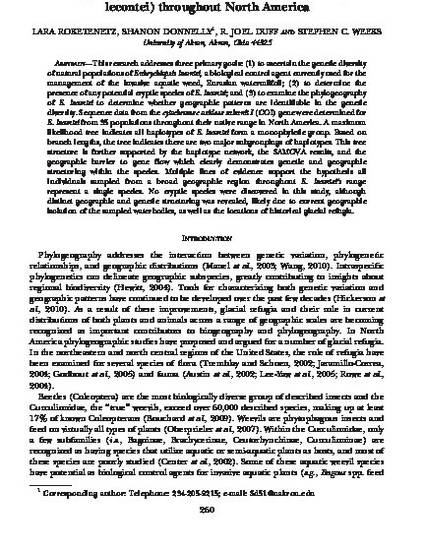
Article
Phylogeographic Characterization of Genetic Variation in the Biological Control Agent Milfoil Weevil (Euhrychiopsis lecontei) throughout North America
American Midland Naturalist
(2017)
Abstract
This research addresses three primary goals: (1) to ascertain the genetic diversity of natural populations of Euhrychiopsis lecontei, a biological control agent currently used for the management of the invasive aquatic weed, Eurasian watermilfoil; (2) to determine the presence of any potential cryptic species of E. lecontei; and (3) to examine the phylogeography of E. lecontei to determine whether geographic patterns are identifiable in the genetic diversity. Sequence data from the cytochrome c oxidase subunit I (COI) gene were determined for E. lecontei from 35 populations throughout their native range in North America. A maximum likelihood tree indicates all haplotypes of E. lecontei form a monophyletic group. Based on branch lengths, the tree indicates there are two major subgroupings of haplotypes. This tree structure is further supported by the haplotype network, the SAMOVA results, and the geographic barrier to gene flow which clearly demonstrates genetic and geographic
structuring within the species. Multiple lines of evidence support the hypothesis all individuals sampled from a broad geographic region throughout E. lecontei’s range represent a single species. No cryptic species were discovered in this study, although distinct geographic and genetic structuring was revealed, likely due to current geographic isolation of the sampled waterbodies, as well as the locations of historical glacial refugia.
Disciplines
Publication Date
Spring May 12, 2017
Citation Information
Lara Roketenetz, Shanon Donnelly, R. Joel Duff and Stephen C. Weeks. "Phylogeographic Characterization of Genetic Variation in the Biological Control Agent Milfoil Weevil (Euhrychiopsis lecontei) throughout North America" American Midland Naturalist Vol. 178 (2017) p. 260 - 274 Available at: http://works.bepress.com/stephen_weeks/16/
